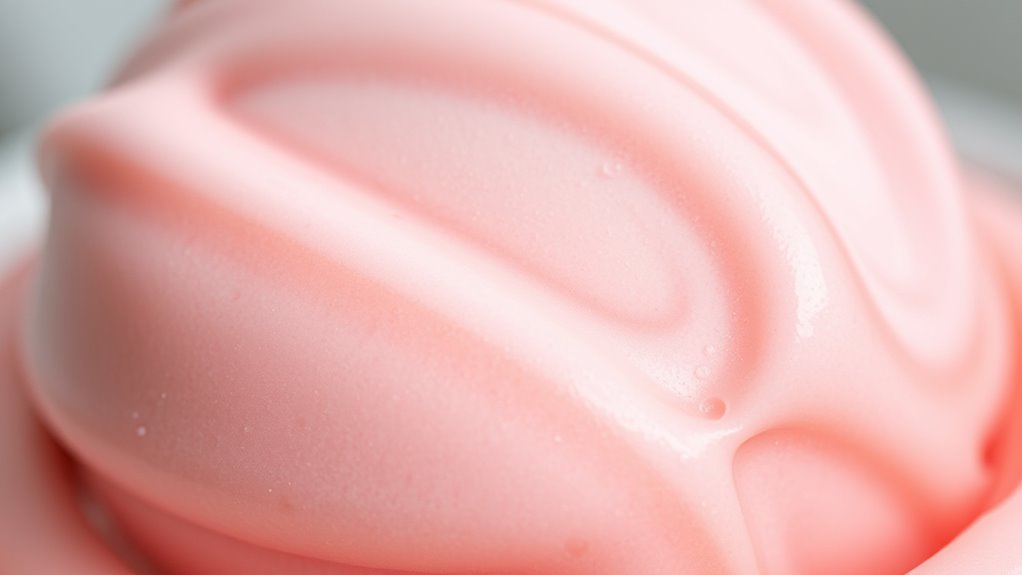To achieve ultra-smooth gelato, leverage next-level emulsifiers like soy lecithin and explore natural stabilizers such as sunflower lecithin and plant-based gums. These ingredients help blend fats seamlessly, prevent ice crystal formation, and create a velvety texture that melts effortlessly. Experimenting with combinations and techniques like high-shear mixing or microfiltration enhances stability and consistency. Continue exploring these advanced methods to elevate your gelato’s quality and impress your customers.
Key Takeaways
- Combining soy lecithin with plant-based stabilizers enhances emulsification, resulting in ultra-smooth, velvety gelato textures.
- Microfiltration and high-shear mixing techniques improve the distribution and breakdown of fat globules for better consistency.
- Incorporating natural stabilizers alongside emulsifiers prevents ice crystal formation and maintains stability during storage.
- Experimenting with alternative emulsifiers like sunflower lecithin can cater to vegan and allergy-sensitive consumers.
- Fine-tuning ingredient ratios and processing methods optimizes gelato creaminess and elevates overall product quality.

Have you ever wondered what keeps gelato smooth, creamy, and perfectly mixed? The secret often lies in the use of emulsifiers, which help blend fats and water-based ingredients seamlessly. As craft gelato makers seek to achieve that ultra-smooth texture, many turn to plant-based alternatives and texture enhancement techniques to elevate their creations. Soy lecithin, a popular plant-derived emulsifier, plays a pivotal role here. It’s derived from soybeans and offers a natural, versatile way to improve the stability and mouthfeel of your gelato. By incorporating soy lecithin, you can reduce ice crystal formation and create a more uniform, velvety texture that melts effortlessly on the tongue.
Emulsifiers like soy lecithin create smooth, velvety gelato textures by preventing ice crystal formation.
But soy lecithin isn’t the only option. As you explore plant-based alternatives, you’ll find that ingredients like sunflower lecithin or even certain gums and stabilizers can serve as effective texture enhancers. These ingredients work by surrounding fat droplets, preventing them from coalescing, and ensuring that your gelato remains smooth and creamy throughout storage and serving. Texture enhancement techniques also involve adjusting the ingredient ratios and processing methods—such as incorporating microfiltration or high-shear mixing—to achieve a more refined product. These methods help break down fat globules and distribute them evenly, resulting in a refined, luxurious mouthfeel that customers will love. Detection of passive voice techniques can also be employed to refine the writing style and improve clarity.
Using plant-based alternatives aligns with current trends toward healthier, sustainable ingredients. They not only make your gelato suitable for vegan and allergy-sensitive consumers but also contribute to a cleaner label. When you incorporate these plant-based emulsifiers, you’re leveraging their natural properties to improve stability and texture without relying on synthetic additives. This approach allows you to craft gelato that’s both environmentally friendly and deliciously smooth.
Moreover, integrating texture enhancement techniques with plant-based emulsifiers empowers you to fine-tune your gelato’s consistency. For instance, combining soy lecithin with other natural stabilizers can boost emulsification, ensuring your gelato maintains its desired creaminess even after multiple freeze-thaw cycles. The key is understanding how these ingredients interact and experimenting with different combinations to find the perfect balance for your specific recipes.
In the end, embracing plant-based alternatives and texture enhancement techniques isn’t just about improving aesthetics; it’s about creating a superior product that delights your customers’ senses and aligns with modern dietary preferences. With the right emulsifiers and methods, you can elevate your gelato to next-level smoothness, setting your offerings apart in the competitive world of frozen desserts.
Frequently Asked Questions
Can Emulsifiers Affect Gelato Flavor Profiles?
Emulsifiers can definitely influence your gelato’s flavor profiles, as well as its mouthfeel. They enhance flavor by improving ingredient blending and reducing separation, leading to a more consistent taste experience. Additionally, emulsifiers modify mouthfeel, making your gelato smoother and creamier. By carefully selecting and using emulsifiers like soy lecithin, you can achieve not only an ultra-smooth texture but also subtly elevate the flavor profile, making your gelato more appealing.
Are Natural Emulsifiers Preferable Over Synthetic Options?
Choosing natural alternatives over synthetic additives is like picking a fresh garden over processed snacks—you often get a purer, more wholesome flavor. Natural emulsifiers, like soy lecithin, appeal because they’re derived from real ingredients and usually better for health. While synthetic additives can be effective and cost-efficient, many prefer natural options for cleaner labels and fewer potential additives, making your gelato not just smooth but also more naturally delightful.
How Do Emulsifiers Influence Gelato Shelf Life?
Emulsifiers play a essential role in gelato’s shelf life by enhancing stability and preventing separation. When you use high-quality emulsifiers, like soy lecithin, they improve emulsifier stability, which helps extend shelf life. This means your gelato stays smoother and fresher longer. By choosing effective emulsifiers, you guarantee your product maintains its texture and quality over time, making it more appealing and durable for storage and sale.
Can Emulsifiers Be Customized for Specific Textures?
Did you know that 85% of consumers prefer gelato with a perfect, velvety texture? You can customize emulsifiers to achieve specific textures by creating custom emulsifier blends and texture-specific formulations. This allows you to fine-tune creaminess, smoothness, or firmness, ensuring your gelato meets exact preferences. By experimenting with these tailored blends, you create unique sensory experiences that stand out and satisfy customer cravings.
Are There Health Considerations With High Emulsifier Usage?
You should consider allergy considerations and digestive impacts when using high levels of emulsifiers. Some people may have allergies to soy lecithin or other emulsifiers, leading to reactions. Additionally, excessive consumption might cause digestive issues like bloating or discomfort. It’s wise to use emulsifiers in moderation and be aware of any sensitivities. Always check ingredient labels and consult with health professionals if you have concerns about allergies or digestion.
Conclusion
By exploring advanced emulsifiers like soy lecithin and beyond, you subtly elevate gelato to a domain of unparalleled smoothness and richness. These gentle enhancements whisper promises of delight with every spoonful, inviting you to indulge in a truly luxurious experience. Embracing these innovations lets you craft desserts that caress the senses and leave lasting impressions. Ultimately, it’s about creating moments of pure bliss—where every bite feels like a cherished secret just waiting to be uncovered.









